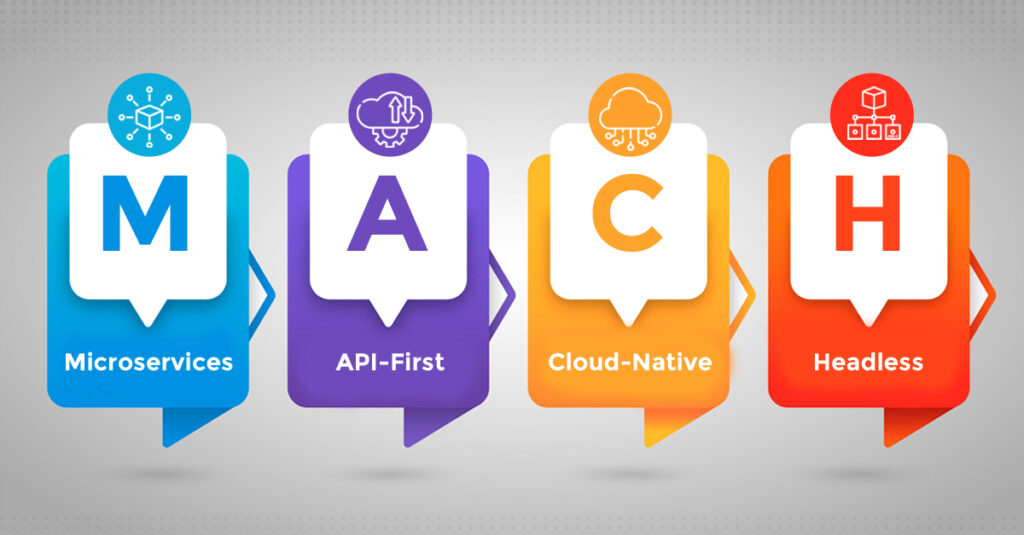Despite the undeniable benefits of MACH commerce, such as flexibility, scalability, and speed, transitioning from traditional systems is not always straightforward. Like any significant technological shift, implementing the MACH architectural approach has a set of challenges. Recognizing these challenges earlier and planning for them is crucial to a smooth transition. Some common hurdles businesses face and some practical ways to overcome them.
Challenge 1: Managing More Complexity.
The Problem: Moving out of a monolithic platform to many independent microservices and APIs introduces more moving parts. The interactions, dependencies, and overall orchestration of such distributed components are rather daunting compared to tackling a single big system. Keeping track of everything takes another approach.

How to Solve It:
- Strong Governance and Documentation: Establish clear criteria for API design, development methods, and deployment processes early on. Teams need comprehensive, accessible documentation for every microservice and API to understand how things connect and operate.
- Robust Monitoring and Observability: Invest in tools that offer you visibility over your distributed system. You have to track performance, find bottlenecks, & troubleshoot problems that might impact numerous microservices. Centralized logging and tracking are required.
- Begin slowly: You don’t have to purchase everything new immediately. Begin by decoupling ONE function (checkout/search) with MACH principles. Learn from this smaller project if you tackle bigger parts of the system.
- Consider Orchestration Tools: Service meshes (e.g., Istio, Linkerd) and dedicated API gateways can deal with communication, observability and security between microservices but are a new layer of complexity at first.
Challenge 2: Lack of Skills and Skills Gap in Organizational Shift.
The Problem: MACH commerce not only tends to be an organizational and cultural change but also a technology change. It thrives in DevOps and cross-functional teams as well as agile development. Traditional, siloed IT structures might have trouble adapting. Also, teams could require skills in cloud-native development, microservice architecture, API design, and other specific cloud platform services that may not be available internally.
How to Solve It:
- Clarify Requirements: Before you choose a tool, define the business capabilities you need for each function (search, payments, etc.).
- APIs: Compliance with APIs should be a top priority when evaluating vendors.
- Start with core functions: Select robust solutions for core commerce capabilities first and work outwards.
- Full Vendor Assessment: Beyond Features. Think of vendor support, long-term roadmap, community and integration with ease. Avoid locking yourself into excessively proprietary ecosystems even in a modular setup.
- Plan an Integration Strategy: Plan how services will connect and exchange information via APIs from the start.
Challenge 3: Initial Investment and ROI Proving
The Problem: Introducing a new MACH commerce architecture – especially migrating out of a legacy monolith – is an expensive upfront investment. This includes development time, brand-new tooling costs, cloud infrastructure setup, staffing, training, etc. This cost usually can not be justified with a clear return on investment because many benefits, such as agility and future readability, are not immediately apparent compared to direct cost savings.
How to Solve It:
- Concentrate on Total cost of Owning (TCO): Higher upfront costs may be required, but MACH will deliver a lower TCO with reduced upkeep on legacy systems, more effective scaling, and faster feature deployment (lowering opportunity costs). Frame the investment in terms of these long-range benefits.
- Pilot Projects / Phased Rollouts: Begin with a specific project or business unit where MACH can provide quick and measurable improvements, such as increasing conversion rates through a new headless frontend or reducing scaling costs for a microservice. Use those wins as momentum and justification to invest more.
- Agility Metrics: Track deployment frequency/lead time for modifications and time to market for new features. These are examples of agility gains that MACH allows and that result in business value.
Anticipating such typical challenges and developing strategies to meet them will help companies move fast towards a flexible, elastic and future-proof MACS commerce architecture.


